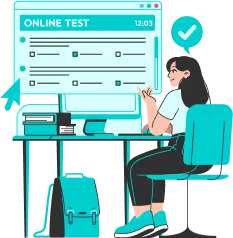Reading: Fill in the Blanks
- 4 min read

 About Reading Fill in the Blanks
About Reading Fill in the Blanks- Task - A text appears on screen with several gaps. Drag words from the box below to fill the gaps.
- Skills assessed - Reading
- Prompt length - Text up to 80 words
There is a passage with some missing words. You have a list of words in the blue box that you can use to fill the gaps in the text. There are more words than gaps so you will not use all the words provided.
Left-click on a word to select it; keep the left mouse button held down and drag the word to the gap where you want to place it. You can also drag words between gaps. To remove a word from a gap, drag it back to the blue box.
Read Also: Re-Order Paragraphs
 Test Tips:
Test Tips:Think about words that you often see or hear together:
Remember that some words often go together to form a familiar phrase. This is called ‘collocation’. Using collocation can help you recognize the correct word for each blank. For example, the phrase ‘the general public’ is a common collocation, so you can quickly see that ‘public’ might be a good choice for the first blank in the sentence below:

Use your knowledge of grammar to help you select the correct word:
Read around the blank in the text and decide what part of speech the missing word is. In the example below, ‘beginning to’ tells you that an infinitive verb form is missing ‘to + verb’. Next look at the answer options provided and rule out any words that are not the right part of speech, e.g., ‘world’ is a noun and ‘formal’ is an adjective. Also, rule out any verbs that are not in the infinitive form.
Finally, choose from the words that are left, the one that has the correct meaning: ‘view’ and ‘look’ mean ‘see’, but we ‘quote’ or ‘cite’ references, so only ‘cite’ fits the blank:

 How this question is scored:
How this question is scored:- This question type affects the scoring of only reading.
- Your listening, speaking and writing skills are not tested by this question type.
Source: https://pearsonpte.com
 Tips By ALFA:
Tips By ALFA:
Go with simple logic: If you are not confident in your grammar, you can still fill in the blanks by following simple logic. Read the sentence with the blank and ask yourself what kind of word is needed to complete a sentence. For example, if the sentence describes an action, then ask yourself what is needed? Maybe what’s missing is the person who performed that action or the way that action was performed. Then look at the words in the pool and pick the ones which fit that criterion.
Evaluate options one by one: A simple approach is to just pick options from the pool, one by one, put them in a blank and see if it completes the sense. Does it make sense? Is the meaning logical? You will be able to fill in a lot of blanks using this approach.
Read something every day: Make it a habit to read something every day. Start by practicing on the portal. You can also read a newspaper on a general website, it is preferred because it can expose you to a variety of topics. If all you read is fiction or scientific articles, you will be exposed only to one kind of vocabulary. The more you read, the more familiar you will become with different sentence structures and word usage patterns. Your mind will pick on these in the exam and you will find fill in the blanks much easier.
Go through the word list: A good vocabulary is essential for any English exam but is especially useful in this question type. Check out and create your own vocabulary word list if you haven’t already done so. !
Get to know collocations: A collocation is a group of words that frequently appear together. They are often used in the fill in the blanks questions. You will have one word from the collocation missing. So, if you are familiar with this list, you will find such questions easier to handle.



